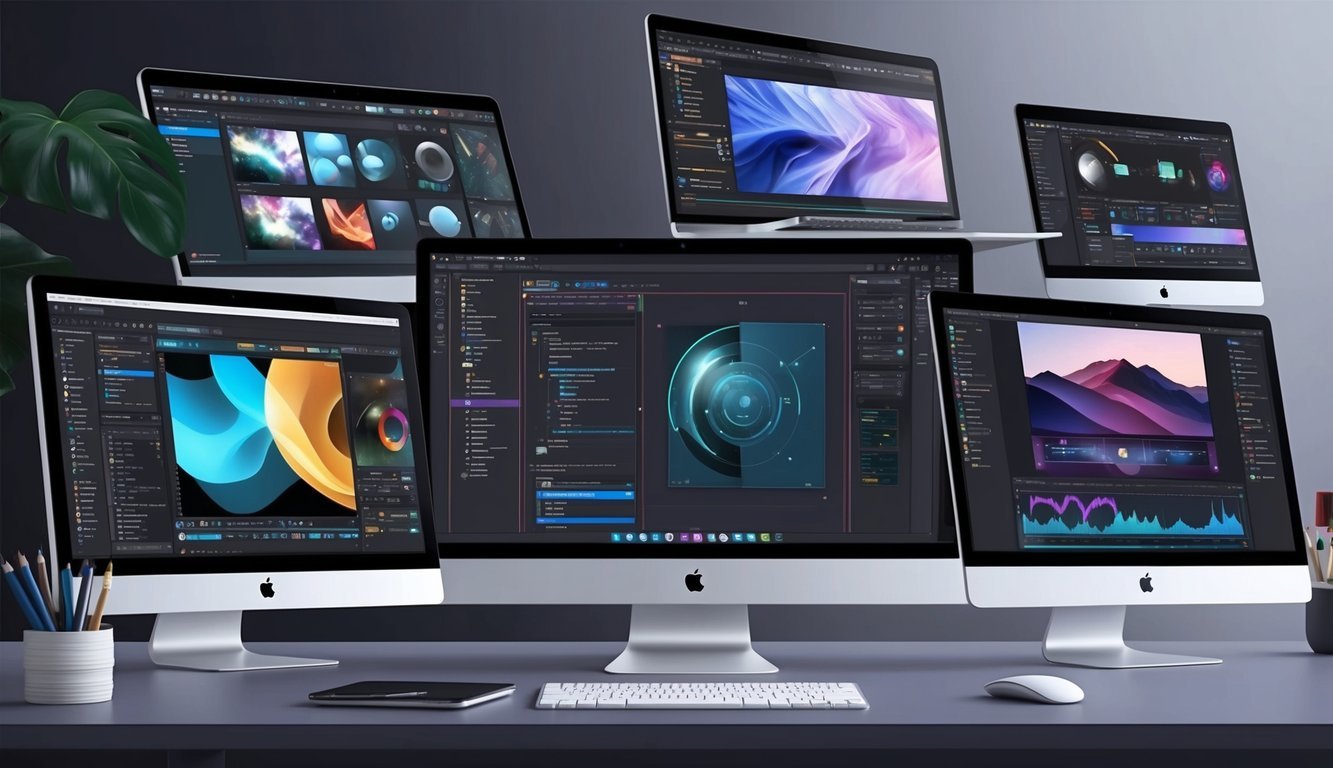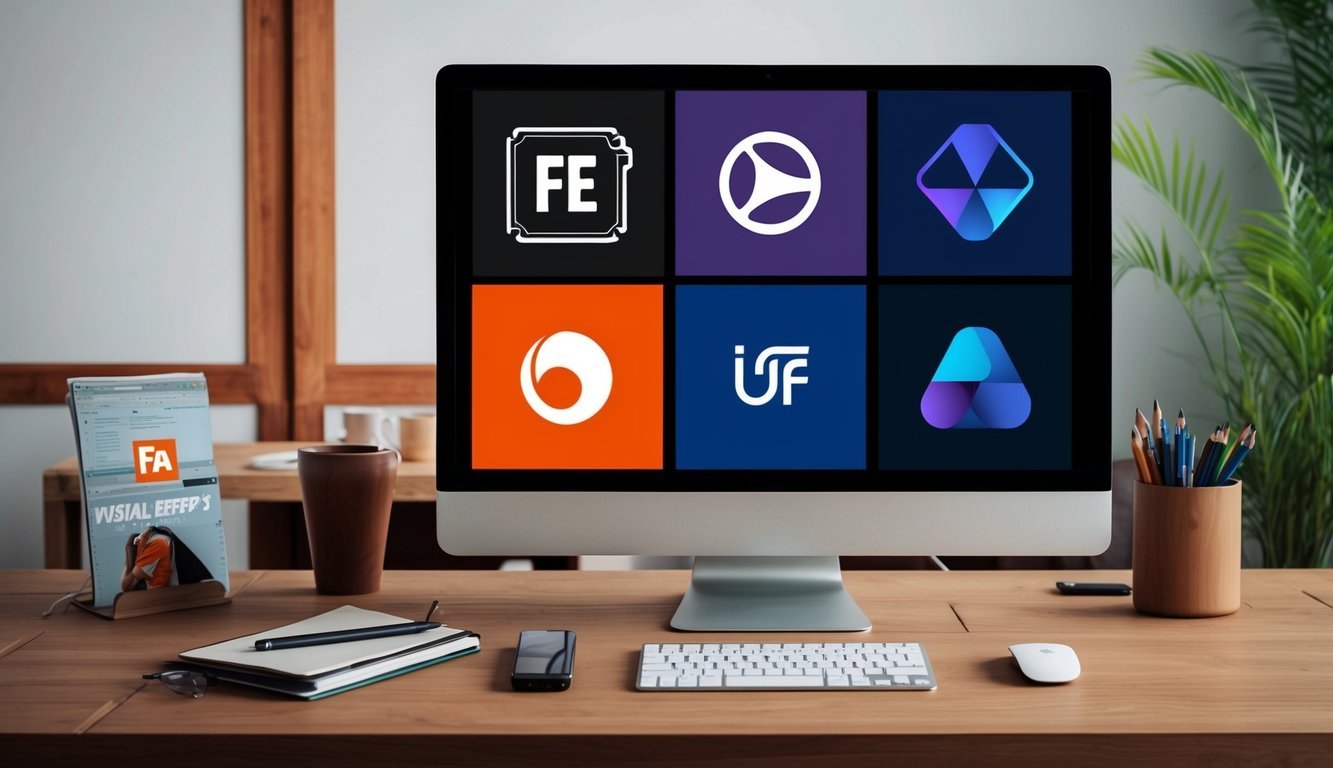Visual effects are the magic that breathes life into movies and videos.
They can transform the everyday into something extraordinary.
Ever wondered how filmmakers whip up those eye-popping scenes? Let’s dive into the world of VFX software that makes it all happen!
The best VFX software is your ticket to creating stunning visual effects for your own projects. Whether you’re just starting out or you’re a seasoned pro, there’s a program out there that fits your needs.
Let’s check out some of the top contenders that can add a sprinkle of magic to your videos.
1) Adobe After Effects
Adobe After Effects isn’t just another program; it’s a staple in the visual effects landscape.
Filmmakers of all kinds, from big shots to indie creators, swear by it.
You can whip up incredible motion graphics and eye-catching effects.
Got a wild idea? With After Effects, you can make things disappear, add wild weather effects, and even tackle 3D animation and explosive touches.
What’s not to love? If you’re already familiar with Premiere Pro or Photoshop, you’ll slide right into using After Effects.
The seamless integration is a treat.
Don’t feel overwhelmed if you’re a beginner! There’s a treasure trove of tutorials to get you started, and the software keeps evolving with new features.
Whether you’re crafting a short film or spicing up a YouTube video, After Effects is a powerhouse for blending live-action footage with 3D models.
Get ready to create the jaw-dropping scenes you’ve been dreaming about!
2) Nuke by Foundry

Nuke is what you might call the heavyweight champ of visual effects.
It’s a go-to in countless big-budget films, renowned for its node-based compositing that makes tackling complex VFX projects a breeze.
This software shines when you’re knee-deep in intricate VFX work.
Whether you’re after stunning 2D effects or diving into 3D, Nuke’s flexible pipeline can adapt to whatever you’re cooking up.
And if 3D movies are your jam, you’re in luck! Nuke supports stereoscopic workflows, letting you juggle multiple camera perspectives with ease.
Plus, its scripting options can save you tons of time—use Python to automate tasks and streamline your workflow.
Honestly, Nuke can be a bit of a tough nut to crack at first.
But don’t sweat it! Check out the many tutorials available, and soon enough, you’ll be crafting mind-blowing effects!
3) Autodesk Maya
Autodesk Maya is a heavyweight in the realm of 3D animation and visual effects.
You’ll find this bad boy powering major blockbusters, TV shows, and video games alike.
With its extensive toolkit for character creation, animation, and cool effects, it’s a must-have.
Maya excels at modeling detailed 3D objects.
Whether you’re sculpting characters or building intricate environments, it’s got you covered.
Plus, its rigging tools make your characters move like they’re alive!
When it comes to animation, Maya really turns on the charm.
You can animate with keyframes or motion capture, and simulate natural elements like cloth, hair, and fluids.
Its rendering capabilities are no slouch either, allowing you to create stunning images with various styles, thanks to integration with popular renderers like Arnold.
Sure, learning Maya can take some time, but trust me, it’s worth it.
Top artists in the industry swear by it, and Autodesk even offers free licenses for students and educators.
It’s a great way to learn without emptying your wallet.
4) Blender
If you’re looking for a free, open-source powerhouse in visual effects, Blender is your go-to.
You might be surprised at just how much you can achieve without spending a dime!
Blender offers robust camera and object tracking tools that allow you to import raw footage and track it in real-time—all without having to juggle between multiple applications.
Pretty slick, right?
You can use Blender for 3D modeling, animation, and even video editing.
It’s like the Swiss Army knife for VFX artists! With both automatic and manual tracking options, you can pick what works best for your project.
What’s really cool is Blender’s vibrant community.
You’ll find loads of tutorials and resources online to help you along the way.
Plus, since it’s open-source, you can look forward to new features regularly.
While mastering Blender may take a bit of time, the outcome can be professional-level work without the expensive price tag.
Give it a shot; your creativity might just surprise you!
5) Cinema 4D

Cinema 4D is a top-tier program for 3D animation and modeling, perfect for crafting jaw-dropping visual effects and graphics across movies, TV shows, and video games.
The best part? It’s user-friendly.
Even if you’re just starting your 3D journey, you’ll find it easy to navigate.
The interface is designed not to overwhelm, making it approachable for newcomers.
One of Cinema 4D’s standout features is its stellar rendering capabilities.
You can whip up stunningly realistic 3D scenes and objects that almost leap off the screen.
It plays well with other VFX programs too.
Need to create amazing effects? Using it alongside After Effects can yield fantastic results.
With plenty of built-in tools for modeling, texturing, and animating, you’ve got the freedom to create everything from simple shapes to complex characters and environments.
If you’re looking to sharpen your VFX skills, Cinema 4D is definitely worth checking out.
It’s a trusted tool in the industry, and you’ll be in good company as a creator.
6) Houdini by SideFX

Houdini is another heavyweight in the VFX game.
If you’re serious about creating some jaw-dropping 3D animations and special effects, this software is your friend.
Crafted by SideFX, Houdini equips you with tools to design, create, and enhance 3D animations in your projects.
If you’re into simulating particles and dynamic effects, you’re in for a treat.
Its procedural workflow makes it ideal for effects that need to react to changes on the fly.
Want to create real-time effects for games or interactive media? Houdini has you covered there too.
You can learn to develop and optimize real-time effects.
Just a heads-up—Houdini FX is a pricy piece of software at around $4,495.
But, if you’re just starting out, there’s an indie license for $269 that can ease you into the world of VFX without breaking the bank.
Understanding Visual Effects Programs

VFX programs have dramatically changed how movies and TV shows are crafted.
These powerful tools allow artists to create scenes that seem impossible, bringing entire worlds to life.
Let’s take a peek into how it all started and what features to look for in visual effects software.
The Evolution of Visual Effects Software
VFX software has come a long way since the early days of filmmaking.
Back in the 1970s, computer-generated imagery (CGI) began making its mark on the big screen.
A turning point came with “Jurassic Park” in 1993, which really showcased what computers could do for special effects.
As technology progressed, software like Adobe After Effects gained popularity in the ’90s, enabling artists to easily add effects to videos.
Fast forward to the 2000s, and 3D applications like Maya and Houdini opened the gates for creating whole digital environments!
Nowadays, even free programs like DaVinci Resolve can work wonders.
VFX have become a cornerstone of nearly every movie and TV show you watch.
Must-Have Features
When choosing VFX software, a few key features should be on your radar.
Start with good compositing tools.
They let you blend different video layers and effects seamlessly.
Look for solid 3D modeling and animation capabilities, which are essential for creating objects and characters from scratch.
Motion tracking is a must too; it allows effects to stick to moving elements in your video.
Don’t overlook render speed.
The faster your program processes effects, the more time you can spend being creative.
Some software, like HitFilm Pro, offers faster rendering in their premium versions for a smooth workflow.
Lastly, check whether the software supports plugins.
These add-ons can enhance your experience and let you add unique touches to your work.
Many pros rely on plugins to speed things up and add extra pizzazz!
Current Trends in the Industry

The world of visual effects is evolving faster than ever.
Exciting new technologies and techniques are reshaping how films and shows get made.
Let’s dive into what’s trending in the VFX universe right now.
Tech Innovations
AI is really shaking things up in VFX.
It’s speeding up tasks that used to take ages.
You can now whip up realistic digital humans in no time—how cool is that?
Virtual production is becoming the norm.
It allows filmmakers to see effects in real-time while shooting.
Forget the days of waiting weeks to see how a shot turned out.
3D scanning and photogrammetry are stepping up their game too, making it easier to create super detailed models of real objects and places.
Impact on Filmmaking Today
VFX are changing the storytelling game.
We’re seeing epic, fantastical scenes that look completely real.
And it isn’t just big studio flicks; indie films are starting to dive into VFX as well.
More affordable, user-friendly tools mean anyone can sprinkle some movie magic!
Plus, VFX are blurring the lines between reality and animation.
You might watch a scene and have trouble figuring out what’s real and what’s not!
This evolution is prompting filmmakers to rethink how they shoot and plan their stories.
It’s a thrilling time to be in the industry!
Frequently Asked Questions

Got questions about VFX software? Let’s tackle some common queries about Hollywood tools, free options, and programs that are easy for beginners.
What VFX software do pros use in Hollywood?
Big-budget movies often rely on Adobe After Effects for compositing and motion graphics.
For more intricate 3D work, Autodesk Maya is a fan favorite.
Plus, Nuke by Foundry is a popular choice for high-end compositing.
Are there any top-notch free VFX programs?
Sure, it has a learning curve, but the end results can be fantastic.
DaVinci Resolve also has a free version with decent VFX features.
Any beginner-friendly visual effects software you recommend?
If you’re just starting out, you can’t go wrong with Adobe After Effects.
It’s user-friendly and packed with online tutorials.
HitFilm Express is another great choice for newbies, and it even has a free version to kick things off.
What’s the most popular VFX software in blockbusters?
Nuke by Foundry is a go-to for many big-budget films, famed for its advanced compositing tools. Autodesk Maya is also widely used for 3D modeling and animation in blockbuster productions.
Can you list some 3D visual effects programs used in the industry?
Which software helped create the visuals in Avengers: Endgame?
The VFX in Avengers: Endgame were a team effort involving multiple programs. Autodesk Maya was vital for 3D modeling and animation, while Nuke was responsible for much of the compositing work.
Also, specialized tools were used for character creation and particle effects.

